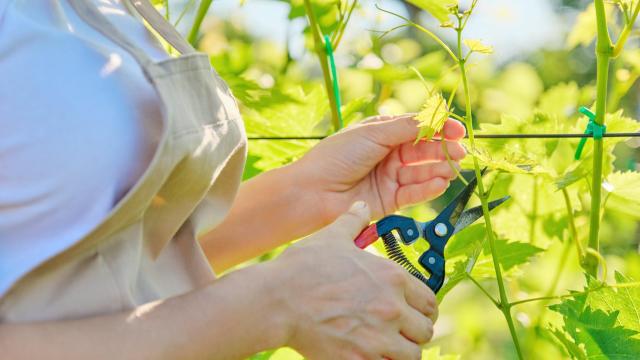When you first bring home a baby plant, you have all kinds of hopes and dreams for it. You can see its full, lush future potential — but in order to get there, it’s going to require a little training. The act of “training” plants — also known as husbandry — is the care and strengthening of plants. Certain techniques (wires, nets, and pruning) can shape your plants for better blooms and optimal growth.
Some methods are easier than others, though, and if you’re just starting out, it can be hard to know which one to try. These beginner techniques will get you (and your plants) going in the right direction.
How to begin low-stress training on houseplants
One of the easiest ways to begin plant training is low-stress training (LST). This method begins when the plant is very young and flexible and (as its name suggests) puts less stress on the plant — and yourself. LST involves bending and securing the plant as it begins to grow. This process separates the leaves and leaf clusters, opening them to allow sunlight to be more evenly distributed. You’ll want twist ties made specifically for plants, or use soft, fuzzy pipe cleaners to gently secure the stem’s newly bent direction.
Gardening site Safer Brand suggests poking holes into the plant’s pot to secure the ties, or using small fishing weights as anchors. Whatever you use, it should be flexible so you can continue to move and bend the plant as needed — but try to avoid metal or hard plastic that can cut into the plant’s stems. Once you have the materials ready, the technique is simple yet delicate. Safer Guard’s technique involves a hook and loop:
Starting with the outermost branches, bend each stem away and down from the middle of the plant. An easy way to do this [is to] form a twist-tie into a hook and loop it around the stem where it won’t break off any limbs or leaves. Use the hook to gradually, gently pull the stem down.
A similar form of LST is wiring, commonly used on bonsai trees. Wiring involves using light, flexible wiring to bend the plant into the shape you choose. This is used in the art of bonsai to create the small trees’ iconic horizontal branches and shape.
How to do “no-technique” plant training
Training plants with the LST technique requires a certain level of attention. You must continue to bend new growth to maintain an open leaf pattern for the light to be evenly distributed and create fuller, bushier plants. The no-technique method is another low-stress method in which you only need to bend the main plant stem. This is a great technique for beginners because it’s nearly a set-it-and-forget-it option. Of course, you will need to monitor the plant, but there’s no need to bend other stems in this process.
How to use a “screen of green” training method
While no-technique and low-stress training manipulate the plants’ shape, “screen of green” or “scrOG” employs a net that promotes upward growth. Nets are usually made of rope, plastic, or metal, and guide the plant to grow upwards rather than inward or to the side. The net is built with PVC piping or metal around the plant and higher than the stems; once the stems begin to reach the fence, they are pulled through or woven to netting.
Grower site California Lightworks instructs growers to take the “outermost branch and pull it outward. Then, weave the branch in and out through the screen. Once that branch is woven in place, continue with the next stem. Work your way inwards stem-by-stem until all branches are woven horizontally throughout your screen.” As more growth reaches the net, it will continue to grow as high as you like. This method is done as the plant is young to encourage upward growth before the stems or sticks have become rigid or grown inward.
What high-stress plant training looks like
Other relatively simple — but a bit more stressful — forms of plant training include topping, in which you remove the tops of stems as they grow. Snipping off the tops signals the plant to produce more sprouts to catch the sun, yielding fuller growth. This process takes more time and stresses the plant, but your plant will grow much fuller if you do it in moderation. Topping is similar to pruning, in which you cut leaves and sometimes stems to shape the plant and promote growth.
Lastly, thinning includes planting several seeds and removing the weaker plants as they grow to ensure the strongest survive. Thinning is a stressful process for the plants (and yourself, since you are essentially killing them), but it creates strong, healthy plants with better opportunities to bud.

Leave a Reply
You must be logged in to post a comment.